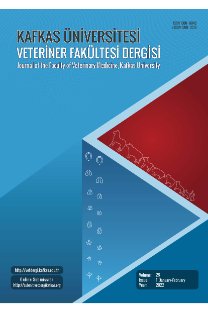Microsatellite Analysis for Parentage Verification and Genetic Characterization of the Turkmen Horse Population
Türkmen At Popülasyonunda Soy Tespiti amacıyla Mikrosatellit Analiz ve Genetik Karakterizasyon
___
- Mahrous KF, Hassanane M, Abdel Mordy M, Shafey HI, Hassan N: Genetic variations in horse using microsatellite markers. J Genet Eng Biotech, 9, 103-9, 2011. DOI: 10.1016/j.jgeb.2011.11.001
- Rafeie F, Amirinia C, Nejati Javaremi A, Mirhoseini SZ, Amirmozafari N: A study of patrilineal genetic diversity in Iranian indigenous horse breeds. Afr J Biotechnol, 10, 75, 17347-17352. 2011.
- Golshan A: Introduction to the Turkmen horse in Iran. 37-71 Tehran, Pejvake Keyhan (in Persian), 2005.
- Burocziova M, Riha J: Horse breed discrimination using machine learning methods. J Appl Genet, 50, 375-77. 2009. DOI: 10.1007/ BF03195696
- Rukavina D, Hasanba D, Pojski N, Rami A, Zahirovi A: Analysis of genetic diversity among certain horse breeds from Bosnia and Herzegovina. Veterinaria, 64, 25-28, 2015.
- Chauhan M, Gupta AK, Dhillon S: Genetic characterization of Indian Spiti horses. J Genet, 83, 291-295, 2004.
- Dierks C, Lohring K, Lampe V, Wittwer C, Drogemuller C, Distl O: Genome-wide searchfor markers associated with osteochondrosi in Hanoverian warm blood horses. Mam Genome, 18, 739-747, 2007. DOI: 1007/s00335-007-9058-9
- Ellegren H, Johansson M, Sandberg K, Andersson L: Cloning of highly polymorphic microsatellites in the horse. Anim Genet, 23, 133-142, DOI: 10.1111/j.1365-2052.1992.tb00032.x
- Marklund S, Ellegren, H, Eriksson S, Sandberg K, Andersson L: Parentage testing and linkage analysis in the horse using a set of highly polymorphic microsatellites. Anim Genet, 25, 19-23, 1994. DOI: 10.1111/ j.1365-2052.1994.tb00050.x
- Dimsoski P: Development of a 17-plex microsatellite polymerase chain reaction kit for genotyping horses. Croat Med J, 44, 332-335, 2003.
- Seyedabadi HR, Amirinia C, Banabazi MH, Emrani H: Parentage verification of Iranian Caspian horse using microsatellites markers. Iran J Biotechnol, 4, 260-264, 2006.
- Rafeie F: Genetic Relationships between Iranian Caspian Horses and Other Iranian Horse Breeds. PhD Thesis, SRBIAU, Tehran, Iran, 2011.
- Moshkelani S: DNA fingerprinting of Iranian Arab horse using fourteen microsatellites marker. Res J Biol Sci, 6, 402-405, 2011.
- Javanrouh A, Banabazi MH, Esmaeilkhanian S, Amirinia C, Seyedabadi HR, Emrani H: Optimization on salting out method for DNA extraction from animal and poultry blood cells. The 57th Annual Meeting of the European Association for Animal Production. 17 to 20 September, Antalya, Turkey, 2006.
- Kalinowski ST, Taper ML, Marshall TC: Revising how the computer program CERVUS accommodates genotyping error increases success in paternity assignment. Mol Ecol, 16, 1099-1106, 2007. DOI: 10.1111/j.1365- X.2007.03089.x
- Rousset F: GENEPOP' 007: A complete re-implementation of the GENEPOP software for Windows and Linu. Mol Ecol Resour, 8, 103-106, DOI: 10.1111/j.1471-8286.2007.01931.x
- Botstein D, White RL, Skolnick M, Davis RW: Construction of a genetic linkage map in man using restriction fragment length polymorphism. Am J Hum Genet, 32, 314-331, 1980.
- Seo JH, Park KD, Lee HK, Kong HS: Genetic diversity of Halla horses using microsatellite markers. J Anim Sci Technol, 58, 1-5, 2016. DOI 1186/s40781-016-0120-6
- Pandey AK, Sharma R, Singh Y: Evaluation of genetic variability in Kenkatha cattle by microsatellite markers. J Anim Sci, 12, 1685-1690, 2006. DOI: 10.5713/ajas.2006.1685
- Georgescu SE, Manea MA, Costache M: The genetic structure of indigenous Romanian Hucul horse breed inferred from microsatellite data. Roum Biotechnol Lett, 13, 4030-4036, 2008.
- Zuccaro A, Bordonaro S, Criscione A, Guastella AM, Perrotta G, Blasi M, D'Urso G, Marletta D: Genetic diversity and admixture analysis of Sanfratellano and three other Italian horse breeds assessed by microsatellite markers. Animal, 7, 991-998, 2008. DOI: 10.1017/ S1751731108002255
- Tozaki T, Kakoi H, Mashima S, Hirota KI, Hasegawa T, Ishida N, Miura N, Choi-Miura NH, Tomita M: Population study and validation of paternity testing for Thoroughbred horses by 15 microsatellite loci. J Vet Med Sci, 63, 1191-1197, 2001. DOI: 10.1292/jvms.63.1191
- Lee SY, Cho GJ: Parentage testing of Thoroughbred horse in Korea using microsatellite DNA typing. J Vet Sci, 7, 63-67, 2006. DOI: 10.4142/ jvs.2006.7.1.63
- Khanshour AM, Conat EK, Juras R, Cothran EG: Microsatellite analysis for parentage testing of the Arabian horse breed from Syria. Turk J Vet Anim Sci, 37, 9-14, 2013. DOI: 10.3906/vet-1104-8
- Cho GJ: Microsatellite DNA polymorphism of Thoroughbred horses in Korea. Korean J Genet, 24, 177-182, 2002. DOI: 10.4142/jvs.2006.7.1.63
- Jakabova D, Trandzik J, Chrastina J: Effectiveness of six highly polymorphic microsatellite markers in resolving paternity cases in Thoroughbred horses in Slovakia. Czech J Anim Sci, 47, 497-501, 2002.
- Curi RA, Lopes CR: Evaluation of nine microsatellite loci and misidentification paternity frequency in a population of Gyr breed bovines, Braz. J Vet Res Anim Sci, 39, 129-135, 2002. DOI: 10.1590/S1413-
- ISSN: 1300-6045
- Yayın Aralığı: 6
- Başlangıç: 1995
- Yayıncı: Kafkas Üniv. Veteriner Fak.
Hacı Ahmet DEVECİ, ABDULSAMED KÜKÜRT, ERDOĞAN UZLU, İBRAHİM SÖZDUTMAZ, OĞUZ MERHAN, MUSTAFA SİNAN AKTAŞ, MERVE ALPAY, İNAN KAYA, MAHMUT KARAPEHLİVAN
Pointer Irkı Bir Köpekte Gebelik Sürecinde Karşılaşılan İdrar Kesesi Retrofleksiyonu
Muhammed Kürşad BİRDANE, İbrahim DEMİRKAN, Erhan ÖZENÇ, Mustafa Volkan YAPRAKÇI
Xiancheng ZENG, Qingli ZHENG, Xuelin CHI
AYŞE MENTEŞ GÜRLER, ALİ YİĞİT, ŞULE SANAL
Gingivitisli Köpeklerde Bazı Sistemik Yangı Parametrelerinin Değerlendirilmesi
BERRİN SALMANOĞLU, Gizem ARALAN, Efe KURTDED, İbrahim ÇİFTÇİ
Hongyun ZHU, Hui ZHANG, Yajing WANG, Danba CIREN, Hailong DONG, Qingxia WU, Mujeeb Ur REHMAN, Fazul NABI, Khalid MEHMOOD, Jingen XU, Jiakui LI
MEHMET ŞAHAL, ABDÜLKERİM DENİZ, Rıfat VURAL, ŞÜKRÜ KÜPLÜLÜ, İBRAHİM MERT POLAT, EKREM ÇAĞATAY ÇOLAKOĞLU, NACİ ÖCAL, Hasan Ceyhun MACUN, MERT PEKCAN, Marion OCAK
Gene Primer SEQUENCE, H. Kaan MÜŞTAK, Kaan ÖNAT, K. Serdar DIKER
Zhitao WANG, Jungang WANG, Yongsheng ZHANG, Xudong WANG, Xiaoli ZHANG, Yu LIU, Jifeng XI, Hao TONG, Qiaoli WANG, Bin JIA, Hong SHEN
Wenyan GAI, Junwei WANG, Juan WANG, Zhigang CUI, Zhina QU, Yundong WANG, Jun HONG, Jinghua CUI, Shigan YAN, Xiaoli DU, Xiumei HUANG, Jianmei ZHAO, Liping ZHU
